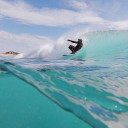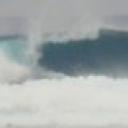Question - Is there a relationship between landbreeze effect and dew point?


Hi Wannabe.
Land and sea breezes are both dependant on the difference in temperature between the ocean and the land.
Overnight the land cools and especially in autumn/winter it gets well below the adjacent ocean temperature.
The air over the ocean at night is warmer than the air over the land, and because hot air rises, the air over the ocean rises, with it being replaced by land on air, blowing out towards the sea in the form of a land breeze.
The opposite happens during the day as the land heats up and we see the sea breeze come in from the ocean to counter the air rising on land.
If the air is more humid it has a greater ability to store and maintain heat, so at night we wouldn't see the land air dropping as much as if it were much drier air.
This would in fact reduce the land breeze effect overnight.
So for the biggest land breeze effect you want dry cold air as to create the largest temperature difference between the adjacent ocean.


Matthew Flinders was the master of predicting when the sea breeze would hit, and that is why his maps were so accurate. I read a book called The Life and Times of Matthew Flinders by Earnest Scott. It was written over 100 years ago.
In it he describes how Flinders would do all his mapping in the morning perched in the crowsnest on the mast with a compass and a barometer. As soon as the barometer would drop just slightly he knew the sea breeze was about to hit and would sail out to sea thus avoiding being pushed onto the coast(no motors in them days of course). He was able to safely sail much closer to the coast than many before him had dared. He drew highly accurate maps in this way. He revolutionised mapping at the time.
In fact when I sailed around Eastern Indo 20 years ago we had nothing but maps drawn by Flinders and a compass to guide us!


That's amazing reading YS, never knew that, love a bit of history!


True to be Mr Yorkesurfer,
You had me so interested and hooked on that info.
Right up to the last sentence and I read it as you sailed around with Matthew Flinders, thats from trying to read too fast and all I saw was Flinders, Flinders everywhere.
Nice one YS


Gidday yorkesurfer, and others. Yeh, that whole topic really interests us here. Flinder's diaries are a classic read. He couldn't really land in Anxious Bay, the sheoaks, and trees were too thick. Ditto in Waterloo Bay. And he talks about how calm and still the bays were. I worked as a carer for a while, and an old lady I looked after in Elliston had some classic photos of when the swamp in town was a huge redgum stand, that stretched all the way to Bramfield. She had a picture of the the early residents proudly cutting down the last massive redgum where the swamp is...to make a track to try and race the first old cars. A swamp formed when all the water the redgums sucked just rose up, and salted up. There is a redgum on a farm I worked on just out of town, that is unbelievably massive. It looks like a forest when you approach it, but it is one huge tree, where massive branches come down to the ground, run along it and then go back up.
I own some land opposite the town right on the coast, that is the highest point, and when you look around you can see out to Mount Wedge. It is like a massive, cleared funnel spreading way out inland. On a hot day, you can watch the heating effect, no trees, to keep things cooler, and feel the breeze/vacuum start, until it just funnels inland like an ever growing tornado.
We can imagine how many light wind and glassy days there would have been when there were forests. The whole area, probably 50,000+ years of Indigenous Australian Cultural fostering and nurturing got flattened in a ridiculously short time. Progress???


Interesting point uplift about the effect of clearing all those trees along the coast there and how the sea breeze comes up stronger and earlier with the heating of the land mass.
There was this old guy named Morrie Kammerman who died last year. He must of been well into his 90's and was a family friend. He lived out his final years in Yanninee but said he used to run the Elliston Caravan Park back in the 1940's. I guess it's the same one you used to manage? He told me about how there were huge trees all along that coastline, parts of which look like a moonscape now. Sad how we can change the environment without a thought of future effects!
He also thrilled me with stories of the old windjammer's that used to ply the coast supplying the towns. One was wrecked in the mouth of Waterloo Bay. A line was fastened and all the people survived and were taken to Port Lincoln. With a storm coming Morrie knew the ship would soon be destroyed so he climbed out to the wreck and removed the navigation board from the Wheelhouse. This was like a dashboard on a car containing a big brass compass, barometer and other instruments. He had it up on his wall and as a kid I used to be fascinated by it. He said "don't tell the museum I have it" as he was scared they would take it away from him!


Gidday Yorkesurfer, yeh its amasing that once it was a hub, a sea port there. The old winch was on the end of the jetty for ages. Lots of stories about the boats, freight and stuff. Yeh, that would have been the park. That huge ridge of sand hills between the park and ocean wasn't even there at first, it formed after all the clearing. Like around Ocean Shores, and Brunswick, that area was so different but sand mining totally transformed that coast. A mate that lives near here is one of the worlds most respected archeologists, and to walk around the place up and down the coast with him is deluxe. He looks at everything so different, and sees things that amase you. You must have some classic stuff there. Even the national parks here, like Coffins, that you just figure were untouched, aren't and are radically different. There are so many fresh water soaks and holes around here, it would have been pretty good living. You can stand by the jetty and find big pools of fresh water coming up out of the sand, and just stand there and drink this beautiful sweet water. You've done well to set yourself up there, I can imagine what you've seen and experienced, and its easy to tell, appreciated.

I gather there is a relationship between the two, but correct me if I am wrong. If there is, how do you check the trend the night before to make a guesstimate of the likelihood of morning offshore bliss. I have been skunked for 2 weeks with early onshores and have the shits.